 |
Our Lady of Good Success
2011 Quito Pilgrimage – Part IV
The Search for Garcia Moreno’s
Corpse Ends
Marian T. Horvat, Ph.D.
Our pilgrimage group moved from the Cathedral where Garcia Moreno’s macerated body was placed before Our Lady of Sorrows to the Dominican Convent of St. Catherine of Sienna. Dr. Francisco Salazar continued his story from the upper choir of its church, where we could see the place in the right hand corner where the body was finally discovered.
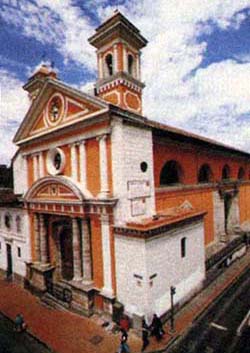
Above, St. Catherine's Church; below, the body was found at the altar's right
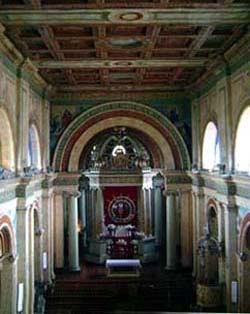 |
After the discovery of Garcia Moreno’s heart on April 11, 1975, Salazar was accompanied by the Bishop to the Dominican Convent, where his research led him to believe the remains of the President were hidden. The Bishop ordered the Mother Superior to cooperate fully in the search.
Decisive evidence appears
The next day, Dr. Salazar spoke with one of the older nuns, Sister Ana Maria Arroyo, who had some interesting information. She had four documents that affirmed that Garcia Moreno’s body had indeed been buried in the convent. One can to see how well kept secrets were in the silence of the cloisters.
She had in her possession three notes signed by a Sister who had safeguarded them for years, after they had been entrusted to her by another Mother whose family had been closely connected to Garcia Moreno. The first one, signed March 19, 1923, said, “I am going to die and I want to confide a secret to you that only a few Mothers know. The venerable remains of the Illustrious Martyr Gabriel García Moreno are in our Church, placed there by his son Gabriel in the company of the Very Reverend Fathers Vacas Galindo and Juan Maria Riera in 1895, when Alfaro took power in our Country. They are located where today we keep the Church ladders. This is recorded for when they will undertake his beatification. She told me others things that I am not saying here, since this seems sufficient.” (Encuentros, p. 23)
A second note, signed by the same Sister and dated February 28, 1941, added a detail: The body had first been buried under the main altar, but then removed because it was feared it might be discovered there.
The third, dated 1959 and addressed to the Cardinal from the Mother Superior at that time, was to notify him a priest had asked permission to search for the body of Garcia Moreno in the Church. The Cardinal’s reply, the fourth note, also dated 1959, explained there was no need to search for the location of the body of Garcia Moreno since he knew exactly where it was and could arrange for its exhumation when he deemed the time right.
But that Cardinal never judged the time right. He died nine years later without exhuming the body or telling anyone the secret. The only recourse for Dr. Salazar was to follow the lead of the main altar and the hint about the ladders. On April 14, 1975, he ordered workmen to raise the floorboards under the main altar. The space was there, but it was empty, as the note had affirmed.
Excavations, but no body
More floorboards were lifted to the right of the altar, then to the left, then on to the side altars. Dr. Salazar complimented the patience of the Mother Superior, who had to bear the checkerboard work he directed of lifting squares of floorboard throughout the Church.
The key question remained unanswered: Where were the ladders stored more than 20 years ago? No one knew. So Dr. Salazar returned to his best source of information, questioning the oldest sisters. One of them took him to the upper choir, where our group was standing that day, and pointed to a place near the door to the right of the sacristy. She recalled being told when she was still young that the Garcia Moreno’s remains were there. It seemed illogical – to store ladders in front of a door, or to bury a body in its doorway.
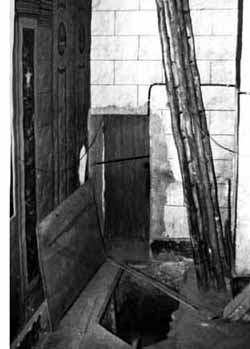
The hole near the side door |
Then he learned the door was only recently constructed, an addition made by the present Mother Superior as an entry for the priest so he would not have to use the main door. The walls around the door were searched. Nothing was found. The floorboards were lifted. Again, nothing.
At the end of the day, Dr. Salazar ordered the workmen to dig into the ground close to the door. Under the floorboards, the workmen found the supporting beam and, around it, earth. They poked the ground with bars. Suddenly, one of them plunged into an empty space. A hole! After removing the soil, they could see a large box in a space about 4 feet deep. The hole was dark, surrounded by earth.
“I’m going in,” Salazar announced.
“Aren’t you afraid of ghosts?” asked one apprehensive sister.
“Not a bit,” he replied, trembling with excitement, not fear, at the thought he was at the end of his quest. Candle in hand, he entered the hole and raised the lid of the box. He saw something bright reflecting the candlelight. It was a crystal vial. In it he could make out a photograph of Garcia Moreno. This is it, he thought. We have the remains of Garcia Moreno. He put his hand in the place he thought the head should be, but only felt some velvet cloth.
He brought the vial up, determined it should be opened and read before further exploration was made. Authorities were called as witnesses, and with two blows, the vial was broken. Inside was the photograph of Garcia Moreno with these words on the back: Portrait of President Garcia Moreno, assassinated August 6, 1875. The picture had been cut to fit in the vial and some of the words had been cut off. It also held two testimonial documents, one signed by a close friend of the President, Rafael Varela and the other by his brother-in-law Ignatius del Alcazar. (1)
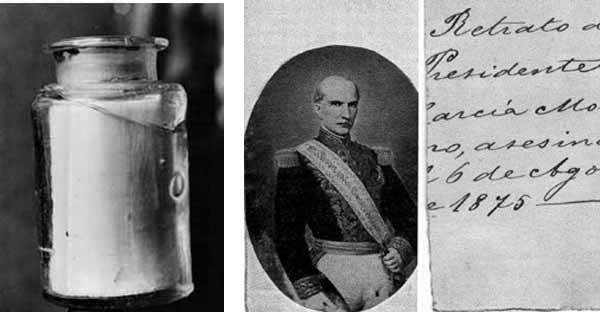
At left, the crystal vial, at right front and back of the photo inside
|
For Dr. Salazar, the most significant line was in the document of Varela, which began, “For relatives or friends in memory of Dr. Gabriel Garcia Moreno.” “This is written for me,” Salazar thought. “I am not a relative or religious, but I am a friend.” He continued, “Still today, every time I retell this story, I am filled with emotion as I recall reading that line and the events of that day.”
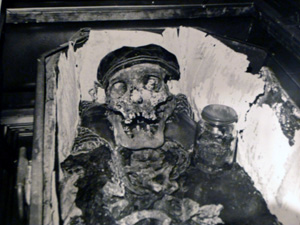
The contents of the coffin |
Cardinal Munoz Vega was notified and arrived shortly to inspect the contents of the box. On its lid, they found the yellow nails spelling GGM. The body had decomposed and only the skeleton remained, as seen in the picture at right. Atop the skull was a velvet cap, which is what Dr. Salazar had felt when he placed his hand in the coffin earlier.
Official confirmation
During the medical examination of the body, it was noted that a small part of the skull was missing. A piece of the skull severed from the head of Garcia Moreno during the brutal assassination was housed at the Espinosa Polit Museum. So that remnant was brought to the Convent. It fit perfectly into the missing place in the skull. “For me and everyone present,” Dr. Salazar told us, "this was the final proof."“
Dr. Salazar placed the box and remains of Garcia Moreno into another coffin that he purchased. The Dominican Church was closed to the public, and on June 27, 1975, the Bishops of Quito met there to verify and officially proclaim that the skeleton was that of Garcia Moreno.
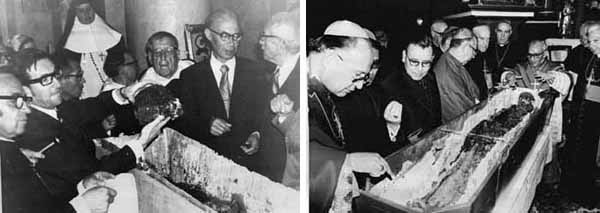
At left, Dr. Salazar lifts the skull to examine, at right, the Prelates examine the remains
|
On August 6, 1975, the 100th anniversary of the death of Gabriel Garcia Moreno, his remains were transferred with solemnity from St. Catherine Church to the Cathedral. There his corpse was placed in a crypt in a side niche to the left of the main altar, where the people of Ecuador - and pilgrims like us - can pay homage to him.
Later Dr. Salazar showed to my friend Judy Mead and me some of his prized relics that he kept in memory of his discovery: some of the lining of the cap found on the skull, the Paris tag and golden cuff from the jacket he was wearing, and his greatest treasure, the first cervical vertebrae from the body of Garcia Moreno.
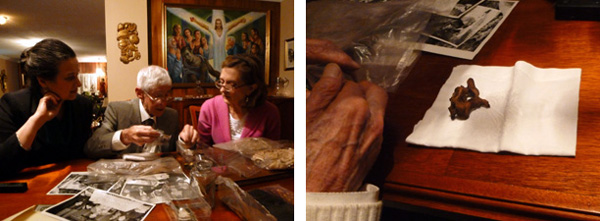
At left, Dr. Salazar displays his treasures to Judy (in pink) and me; at right, the vertebrae of Garcia Moreno
|
We had the privilege to venerate that good-sized relic of the great Catholic President who had so valiantly and successfully defeated the Liberal policies promoted by Freemasonry in that turbulent period of South American history.
Our Lady of Good Success & Garcia Moreno
His interest in Garcia Moreno brought Dr. Salazar to the knowledge of Our Lady of Good Success. He was fascinated to learn that the Our Lady had foretold in the 1600s – with perfect accuracy – that a President would come in the 19th century who would combat Freemasonry, consecrate the Country to the Sacred Heart, and die a martyr’s death.
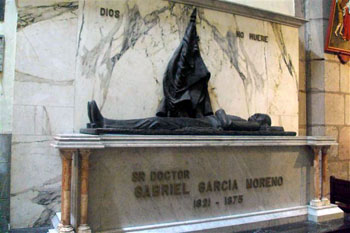
The crypt with Garcia Moreno's remains in Quito's Cathedral
|
By speaking of this man who boldly countered the Liberal politics of his day, I believe Our Lady was clearly showing her disapproval of the new notion of separation of Church and State, always condemned by the Church and Popes.
It is sad to see that today the post-Vatican II Popes and Hierarchy have aligned themselves with the principles of the Enlightenment, which are fundamentally the same ones that Garcia Moreno combated.
Our Lady of Good Success predicted not only the crisis in the Faith that we are experiencing today, but she also announced the restoration of the Church and Christendom. We who share the ideals of the “truly Catholic President” Gabriel Garcia Moreno are also privileged to participate in this fight to establish the Kingship of Christ on earth.
1. The texts of the two letters found in the vial can be read in Encuentro con la Historia, pp 245-255, or Encounter with History, pp. 185-191.

Posted March 11, 2011

Related Topics of Interest
 Part I: Impressions of Our Lady of Good Success Part I: Impressions of Our Lady of Good Success
 Part II: The Last Day of Gabriel Garcia Moreno Part II: The Last Day of Gabriel Garcia Moreno
 Part III: The Discovery of the Hearts Part III: The Discovery of the Hearts
 Part V: "My Sons, I Am Poisoned" Part V: "My Sons, I Am Poisoned"
 Garcia Moreno – Model of a Catholic Statesman Garcia Moreno – Model of a Catholic Statesman
 The Prophetic Mission of Mother Mariana The Prophetic Mission of Mother Mariana
 Prophecies of Fatima and Our Lady of Good Success Prophecies of Fatima and Our Lady of Good Success
 Ecuador, a Nation that Is a Reliquary Ecuador, a Nation that Is a Reliquary
 Our Lady of Good Success Home Page Our Lady of Good Success Home Page

Related Works of Interest
|
Our Lady Good Success | Home | Books | CDs | Search | Contact Us | Donate

© 2002-
Tradition in Action, Inc. All Rights Reserved
|
 |
|